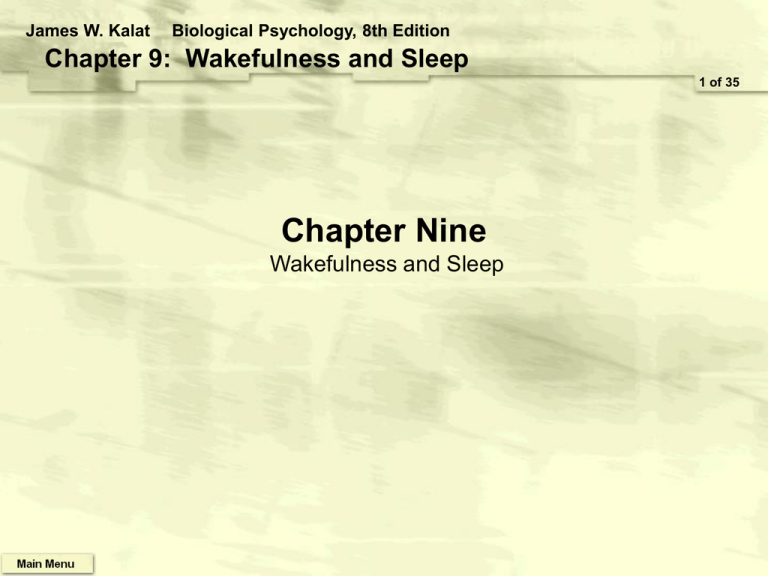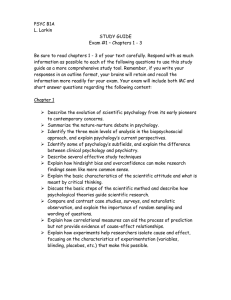Wakefulness___Sleep
advertisement

James W. Kalat Biological Psychology, 8th Edition Chapter 9: Wakefulness and Sleep 1 of 35 Chapter Nine Wakefulness and Sleep James W. Kalat Biological Psychology, 8th Edition Chapter 9: Wakefulness and Sleep 2 of 35 Endogenous Cycles • Endogenous: generated by the body regardless of environment – circannual rhythm: prepares animals for seasonal changes even when caged without clues to the season – circadian rhythm: rhythms that last a day and are synchronized • wakefulness and sleep • hormone secretion • frequency of eating • body temperature James W. Kalat Biological Psychology, 8th Edition Chapter 9: Wakefulness and Sleep 3 of 35 Biological Clock • • Duration for humans is between 24-25 hours (24.2 in one study) – we cannot adjust to 22 or 28 hour day – can be lengthened somewhat by bright lights Insensitive to most interference, e.g., not affected by: – food or water deprivation – x-rays – tranquilizers – alcohol, anesthesia – lack of oxygen – most kinds of brain damage James W. Kalat Biological Psychology, 8th Edition Chapter 9: Wakefulness and Sleep 4 of 35 Suprachiasmatic Nucleus (SCN) • • SCN: area of the hypothalamus that sets circadian rhythm – if damaged, rhythms are less consistent, not synchronized to light and dark patterns – neurons produce circadian rhythm in tissue cultures – genes interact with proteins per and tim to generate rhythm • mutant per gene accelerates biological clock Pineal gland releases melatonin 2 hrs before bedtime – pill may help adjust to new time zone but effect of long term use unknown James W. Kalat Biological Psychology, 8th Edition Chapter 9: Wakefulness and Sleep 5 of 35 Figure 9.3 Figure 9.3 The suprachiasmatic nucleus (SCN) of rates and humans. The SCN is located at the base of the brain, just above the op[tic chiasm. The optic chiasm was torn off when the brain was sliced to make the slides shown in (a) and (b), which show coronal sections through the plane of the anterior hypothalamus. Each rat was injected with radioactive 2-deoxyglucose, which is absorbed by the most active neurons. A high level of absorption of this chemical produces a dark appearance on the slide. Note that the level of activity in SCN neurons is much higher in section (a), in which the rat was injected during the day, than in section (b), in which the rat received the injection at night. (Source: W.J. Schwartz & Gainer, 1977 © A sagittal section through a human brain shows the SCN and the pineal gland.) James W. Kalat Biological Psychology, 8th Edition Chapter 9: Wakefulness and Sleep 6 of 35 Setting and Resetting Biological Clock • Biological clock is primarily reset by light, the zeitgeber, or time giver – blind people produce circadian rhythms longer than 24 hours – under constant bright light, hamsters developed two periods of wakefulness and sleep – also affected by noise, meals, exercise and temperature – marine animals affected by tide James W. Kalat Biological Psychology, 8th Edition Chapter 9: Wakefulness and Sleep 7 of 35 Setting and Resetting Biological Clock cont. • • Jet lag – going west we stay up later and phase-delay our circadian rhythm – going east we sleep earlier and it is phase-advanced – flight attendants experience some memory impairments Shift work – many people may not adjust completely to night work, still feel groggy and do not sleep well during day – less light in night environment James W. Kalat Biological Psychology, 8th Edition Chapter 9: Wakefulness and Sleep 8 of 35 Figure 9.5 Figure 9.5 Jet lag. Eastern time is later than western time. People who travel six time zones east must wake up when their biological clocks say it is the middle of the night, and will try to go to sleep when their biological clocks say it is just late afternoon. James W. Kalat Biological Psychology, 8th Edition Chapter 9: Wakefulness and Sleep 9 of 35 Setting and Resetting Biological Clock cont. • SCN reset by axons in retinohypothalamic pathway from retina to hypothalamus – retinal ganglion cells do not contribute to vision and respond to overall average amount of light – light still resets biological clock in mice with few rods and cones – light resets circadian rhythm in blind mole rats James W. Kalat Biological Psychology, 8th Edition Chapter 9: Wakefulness and Sleep 10 of 35 Stages of Sleep • • • Electroencephalograph (EEG) measures electrical potentials – potentials are net average of all neuron activity, an objective measure of sleep or wakefulness Stage 1 – irregular, jagged, low-voltage waves – activity high but declining Stage 2 – sleep Spindles, burst of 12-14 Hz waves lasting at least half a second – K-complex: sharp high-amplitude negative wave followed by a smaller, slower positive wave James W. Kalat Biological Psychology, 8th Edition Chapter 9: Wakefulness and Sleep 11 of 35 Stages of Sleep cont. • • Stage 3 & 4, slow-wave sleep – start of large amplitude waves at least half second – half of activity is slow-wave by stage 4 – deepest sleep, least responsive to stimuli, hard to awake After about 60-90 minutes, we cycle back from 4 to 3 to 2 and then to rapid eye movement sleep (REM) – repeats all night – early evening: more stages 3 - 4 and less REM – late evening: more REM and less stages 3 - 4 James W. Kalat Biological Psychology, 8th Edition Chapter 9: Wakefulness and Sleep 12 of 35 Rapid Eye Movement (REM) Sleep • • • • • Irregular, low-voltage, fast EEG waves Rapid eye movements and postural muscle paralysis Penile erection and vaginal moistening Irregular heart rate, blood pressure and breathing rates Dreams reported by 80-90% of persons awakened during REM – likely to have more complicated plots and striking visual imagery than non-REM stage dreams James W. Kalat Biological Psychology, 8th Edition Chapter 9: Wakefulness and Sleep 13 of 35 Rapid Eye Movement (REM) Sleep cont. • Research – REM associated with loose associations (e.g., thiefwrong) • possible explanation for why dreams seem to jump around in haphazard, complicated way – non-REM associated with strong associations (e.g., longshort) and simpler dreams James W. Kalat Biological Psychology, 8th Edition Chapter 9: Wakefulness and Sleep 14 of 35 Figure 9.9 Figure 9.9 Polysomnograph records from a male college student. A polysomnograph includes records of EEG, eye movements, and sometimes other data, such as muscle tension or head movements. For each of these records, the top line is the EEG from one electrode on the scalp; the middle line is a record of eye movements; and the bottom line is time marker, indicating 1-second units. Note the abundance of slow waves in stages 3 and 4. (Source: Records provided by T.E. LeVere.) James W. Kalat Biological Psychology, 8th Edition Chapter 9: Wakefulness and Sleep 15 of 35 Brain Mechanisms of Wakefulness and Arousal • • Cut through midbrain separating forebrain and part of midbrain from all lower structures – animal enters prolonged state of sleep because reticular formation is damaged – but, cut each of the individual tracts that enter medulla and spinal cord and animal continues to have normal wakefulness and sleep Reticular Formation:structure in midbrain that extends from the medulla into the forebrain – sends axons into brain and into spinal cord – pontomesencephalon area maintains arousal in wide regions of cerebral cortex James W. Kalat Biological Psychology, 8th Edition Chapter 9: Wakefulness and Sleep 16 of 35 Brain Mechanisms of Wakefulness and Arousal cont. • • • Locus coeruleus: small structure in the pons – emits bursts of impulses in response to meaningful events – important for information storage, almost completely inactive during sleep, maybe why we forget dreams Basal forebrain axons go to thalamus and cerebral cortex – increases arousal, learning and attention – damage leads to decreased arousal, impaired learning and memory, extensive in Alzheimer’s Disease Hypothalamus – couple of paths stimulate arousal by releasing histamine – antihistamines cross blood-brain barrier and cause drowsiness James W. Kalat Biological Psychology, 8th Edition Chapter 9: Wakefulness and Sleep 17 of 35 Getting to Sleep • • • Reduce temperature in the brain and body – body cools when lying down and blood flows to periphery and warms hands and feet Decrease stimulation – quiet room – low or no light Adenosine produces sleepiness – accumulates during the day and declines during sleep – caffeine inhibits adenosine, increasing arousal James W. Kalat Biological Psychology, 8th Edition Chapter 9: Wakefulness and Sleep 18 of 35 Getting to Sleep cont. • • Prostaglandins: chemicals present in much of body that promote sleep – accumulate during the day and decline during sleep; during day – inhibits hypothalamic cells that increase arousal Basal forebrain and hypothalamus promote sleep by releasing GABA, an inhibitory transmitter – if damaged, prolonged wakefulness results – anesthesia works by increasing GABA release James W. Kalat Biological Psychology, 8th Edition Chapter 9: Wakefulness and Sleep 19 of 35 Figure 9.11 Figure 9.11 Brain mechanisms of sleeping and waking. Green arrows indicate excitatory connections; red arrows indicate inhibitory connections. Neurotransmitters are indicated where they are known. Although adenosine is shown as a small arrow, it is a metabolic product that builds up in the area, not something released y axons. (Source: Based on Lin, Hou, Sakai, & Jouvet, 1996; Robbins & Everitt; and Szymusiak, 1995.) James W. Kalat Biological Psychology, 8th Edition Chapter 9: Wakefulness and Sleep 20 of 35 Brain Function in REM Sleep • • • Pons and limbic systems - activity increases (note limbic system is active during emotional arousal when awake) Parietal and temporal cortex - activity increases Primary visual cortex, motor cortex, dorsolateral prefrontal cortex - activity decreases James W. Kalat Biological Psychology, 8th Edition Chapter 9: Wakefulness and Sleep 21 of 35 Brain Function in REM Sleep cont. • • PGO (pons-geniculate-occipital) waves, high amplitude electrical potentials, occur during REM sleep – neural activity first in pons, second in lateral geniculate nucleus of thalamus and third in the occipital cortex – high density of PGO waves after deprivation of REM sleep – each PGO wave is synchronized with an eye movement Cells in pons contribute to REM by inhibiting motor neurons that control body’s large muscles – prevents acting out during sleep James W. Kalat Biological Psychology, 8th Edition Chapter 9: Wakefulness and Sleep 22 of 35 Figure 9.13 Figure 9.13 PGO waves. PGO waves start in the pons (P) and then show up in the lateral geniculate (G) and the occipital cortex (O). Each PGO wave is synchronized with an eye movement in REM sleep. James W. Kalat Biological Psychology, 8th Edition Chapter 9: Wakefulness and Sleep 23 of 35 Abnormalities of Sleep • • • Insomnia: you have insomnia if you feel consistently tired – we often do not get the 6-8 hours of sleep we need – noise, worries, drugs, out of circadian rhythm, diseases, depression, anxiety, etc. – tranquilizers may relieve sleep but create other problems Onset insomnia: trouble falling asleep – body temperature still falling at normal sleep time so can’t fall asleep right away Maintenance insomnia: wake frequently during the night James W. Kalat Biological Psychology, 8th Edition Chapter 9: Wakefulness and Sleep 24 of 35 Abnormalities of Sleep cont. • • Termination insomnia: body temperature rises at normal sleep time so wake up sooner and can’t go back to sleep – rapid entry into REM sleep, ahead of regular onset Sleep Apnea: inability to breathe while sleeping – narrow airway closes in sleep posture, common among obese men (surgery can remove excess tissue) – brain mechanisms for respiration fail to work in elderly (mask delivering air under pressure can help) James W. Kalat Biological Psychology, 8th Edition Chapter 9: Wakefulness and Sleep 25 of 35 Figure 9.15 Figure 9.15 Insomnia and circadian rhythms. A delay in the circadian rhythm of body temperature is associated with onset insomnia; an advance is associated with termination insomnia. James W. Kalat Biological Psychology, 8th Edition Chapter 9: Wakefulness and Sleep 26 of 35 Abnormalities of Sleep cont. • Narcolepsy: gradual or sudden attacks of sleepiness during the day – occasional cataplexy, muscle weakness while the person remains awake – sleep paralysis, inability to move when falling asleep – hypnagogic hallucinations, dreamlike experiences – much like intrusion of REM-like state into wakefulness – treatments • stimulant drugs such as pemoline (Cylert) or methylphenidate (Ritalin) • may relieve sleep but create other problems James W. Kalat Biological Psychology, 8th Edition Chapter 9: Wakefulness and Sleep 27 of 35 Abnormalities of Sleep cont. • • Periodic limb movement disorder – repeated involuntary movement of the legs and arms every 20-30 seconds, may awaken person – common among middle-aged and older – sometimes treated with tranquilizers but may leave person sleepy during the day REM behavior disorder – move around vigorously during REM, acting out dream – multiple areas of damage in pons and midbrain James W. Kalat Biological Psychology, 8th Edition Chapter 9: Wakefulness and Sleep 28 of 35 Abnormalities of Sleep cont. • • • Night terrors – occur during NREM sleep, common in children – nightmares occur during REM (usually can describe) Sleep talking occurs in most people during REM and NREM Sleepwalking runs in families – common in children 2-5, mostly early at night during stage 3-4 sleep James W. Kalat Biological Psychology, 8th Edition Chapter 9: Wakefulness and Sleep 29 of 35 Why Do We Sleep? • Repair and restoration theory – the main function of sleep is to enable the body to repair itself, especially the brain, after the exertions of the day – support • after several days a rat’s immune system eventually fails, loses resistance to infection and brain activity ceases • sleep increases during illness – not supported by fact that how long we sleep is not dependent on activity during the day James W. Kalat Biological Psychology, 8th Edition Chapter 9: Wakefulness and Sleep 30 of 35 Why Do We Sleep? cont. • Evolutionary theory – we sleep to conserve energy, body temperature drops and we save energy • Ex: hibernation (even sleep a lot on days awake) – sleep varies with time needed to search for food and safety from predators • Ex: horses and grazing animals sleep less compared to wolves and other predatory animals – theories are complementary and compatible James W. Kalat Biological Psychology, 8th Edition Chapter 9: Wakefulness and Sleep 31 of 35 Functions of REM Sleep • Effects of REM deprivation – irritability, anxiety, impaired concentration, weight gain, increased appetite – animal experiment with rats led to death – REM rebound: REM sleep increased from 19% to 29% of night’s sleep when allowed to sleep undisturbed James W. Kalat Biological Psychology, 8th Edition Chapter 9: Wakefulness and Sleep 32 of 35 Functions of REM Sleep cont. • Hypotheses – REM helps discard useless connections formed during the day – assists in memory formation, especially motor skills • rats deprived of paradoxical sleep forgot location of platform under water • human males had trouble remembering a motor skill – moving eyes increases supply of oxygen delivery to cornea of eye (don’t get oxygen from blood) James W. Kalat Biological Psychology, 8th Edition Chapter 9: Wakefulness and Sleep 33 of 35 Biological Perspectives on Dreaming • Activation-synthesis hypothesis – during dreams, various parts of the cortex are activated by the input arising from the pons and environmental stimuli • the cortex synthesizes a story to make sense of all of the activity – OR: because there is few stimuli from environment, dreamer may process information stored in memory – vestibular stimuli also may give feeling of flying, falling – feeling of not being able to move true since muscles turned off James W. Kalat Biological Psychology, 8th Edition Chapter 9: Wakefulness and Sleep 34 of 35 Biological Perspectives on Dreaming cont. • Clinico-anatomical hypothesis – dreams begin with arousing stimuli from the brain’s own motivations, memories, and arousal – but brain does not react in normal way • input from V1 primary visual cortex is suppressed • primary motor cortex is suppressed to prevent action • no censorship by prefrontal cortex to say “this is not possible” James W. Kalat Biological Psychology, 8th Edition Chapter 9: Wakefulness and Sleep 35 of 35 Biological Perspectives on Dreaming cont. • Clinico-anatomical hypothesis cont. – inferior parietal cortex and V2 plus visual areas of temporal cortex are active • damage in these areas result in no dreams (parietal cortex) or no visual content (visual areas)





